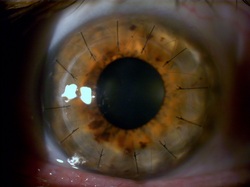Surgical Options

Keratoplasty
Also known as "corneal grafting" this procedure involves replacing your own irregular cornea with a donor cornea. There are several variations, most commonly penetrating keratoplasty (PK) and deep lamellar keratoplasty (DLK).
PK involves removing a full-thickness "button" of cornea about 8mm in diameter. The donor cornea is then sewn into place.
With DLK, the thin back layer of the cornea (called the endothelium) is left in place (so the incision does not quite go through all the layers) and the donor cornea is sewn into place on top of this.
As the donor cornea in foreign to the body, it is possible that the eye may try to reject the donor cornea. While this can usually be managed with medications (typically corticosteriod eye drops), is is probably the most significant reason for graft to "fail".
As DLK leaves the original endothelium intact, there is significantly less chance of rejection when compared to PK. However the visual outcomes (clarity) of PK tend to be better. Generally, which method of keratoplasty is performed is a decision made in conjunction with the ophthalmologist (eye surgeon).
One main reason for considering keratoplasty includes failure to able to maintain a lens on the eye. This is normally due to the keratoconus being so advanced that physically keeping a lens on the eye becomes impossible or risks damage to the eye. The other common reason for surgery is due to corneal scar tissue caused by the keratoconus reducing the vision significantly. Essentially, the cornea "stretchs" and develops scar tissue over the apex (peak) of the cornea. This creates a clouding of vision that contact lenses may not be able to correct effectively.
Keratoplasty is generally considered to be a last resort of patients with keratoconus. It is (almost) certain the a patient will still require either spectacles or contact lenses to correct the vision following keratoplasty.
Also known as "corneal grafting" this procedure involves replacing your own irregular cornea with a donor cornea. There are several variations, most commonly penetrating keratoplasty (PK) and deep lamellar keratoplasty (DLK).
PK involves removing a full-thickness "button" of cornea about 8mm in diameter. The donor cornea is then sewn into place.
With DLK, the thin back layer of the cornea (called the endothelium) is left in place (so the incision does not quite go through all the layers) and the donor cornea is sewn into place on top of this.
As the donor cornea in foreign to the body, it is possible that the eye may try to reject the donor cornea. While this can usually be managed with medications (typically corticosteriod eye drops), is is probably the most significant reason for graft to "fail".
As DLK leaves the original endothelium intact, there is significantly less chance of rejection when compared to PK. However the visual outcomes (clarity) of PK tend to be better. Generally, which method of keratoplasty is performed is a decision made in conjunction with the ophthalmologist (eye surgeon).
One main reason for considering keratoplasty includes failure to able to maintain a lens on the eye. This is normally due to the keratoconus being so advanced that physically keeping a lens on the eye becomes impossible or risks damage to the eye. The other common reason for surgery is due to corneal scar tissue caused by the keratoconus reducing the vision significantly. Essentially, the cornea "stretchs" and develops scar tissue over the apex (peak) of the cornea. This creates a clouding of vision that contact lenses may not be able to correct effectively.
Keratoplasty is generally considered to be a last resort of patients with keratoconus. It is (almost) certain the a patient will still require either spectacles or contact lenses to correct the vision following keratoplasty.
Collagen Cross Linking (CCL)
CCL is a recently developed procedure designed to halt the progression of keratoconus. This is achieved by increasing the rigidity (stiffness) of the cornea preventing it from continuing to distort. The procedure itself (developed in Dresden, Germany), involves removing the thin surface layers of the cornea (epithelium), saturating the cornea with riboflavin (vitamin B2) dye, then treating the area with UV light. The UV reacts with the riboflavin to increase the bonding between the collagen fibres that make up the cornea. The effect is a greatly increased rigidity and resistance to progression of the keratoconus. It does not cure the keratoconus but prevents it getting worse. Collagen cross linking is an exciting procedure that should reduce the numbers of patients requiring keratoplasty (corneal grafting).
CCL must be performed before the keratoconus gets too advanced, therefore it is recommended all keratoconic patients with children have them tested for keratoconus (with corneal topography) from the age of 8. This will ensure that if keratoconus develops it is diagnosed early.
Intacs
These are small semi-circular plastic rings that are implanted into the cornea. The idea is to "stretch" the central cornea, causing it to flatten and reduce the visual distortion. The results tend to be variable and although they may improve the vision to some degree in mild cases, they do not usually eliminate the the need for contact lenses. They are seldom of benefit in more advanced cases of keratoconus. However, they are able to be removed should the need arise.
